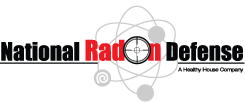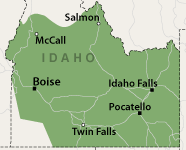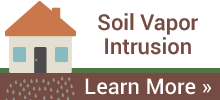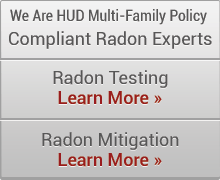
Indoor Air Quality & Pollutants
Learn about indoor pollutants that may be making your family ill

5 Danger Levels of Indoor Air Quality
These are the 5 danger levels of indoor air quality. For each danger level, there is a solution to reduce health risks.
It’s helpful to view the big picture of indoor air pollution. That way you can focus on those that are the most hazardous pollutants while developing a plan to rid your home of less deadly (but still serious) air quality problems.
National Radon Defense is devoted to helping you make your home healthier. We are indoor air quality (IAQ) specialists who can prevent radon gas from entering your home and alleviate a host of other pollutants. We have the equipment to monitor your home for particle allergens, chemical pollutants, carbon monoxide, humidity, temperature, and carbon dioxide.
Call us today or contact us online for an appointment to have your indoor air quality evaluated. We are Central and Southern Idaho's leading radon and indoor air quality contractor serving Boise, Meridian, Idaho Falls and nearby areas.
From dust to radon, see how these pollutants affect your home
There are five levels of indoor air pollution danger with "dangerous gases” being the most serious. Please review each level to see how each one applies to your home. We’ve prepared short videos to help inform you about each level.
Danger Level 5: Dangerous Gases
Radon and carbon monoxide are potentially deadly gases that exist in many homes across the U.S. Approximately one in fifteen homes has high levels of radon gas. What makes these gases of particular concern is that they are odorless, tasteless, and invisible. Radon gas occurs naturally as uranium in soil and rock decays. It may enter the home through cracks and penetrations in slabs and foundations.
Carbon monoxide (CO) is produced by malfunctioning fuel-burning appliances, such as furnaces, boilers, water heaters, and wood stoves. Idling automobiles and outdoor power equipment also produce CO.
Together, radon and carbon monoxide are responsible for thousands of deaths every year in the United States and Canada. In fact, radon-caused lung cancer kills 15,000 to 21,000 people a year in the U.S. alone.
Danger Level 4: Microbial Growth
Fungus, including mold and mildew, can cause a wide variety of ailments. As these micro-organisms grow, they produce microscopic spores that can travel on air currents from their sources to all areas within the home. They are so tiny they can easily enter your lungs as you inhale.
The reaction of sensitive individuals ranges from mild to severe. Symptoms include nose and throat irritation, nasal stuffiness, wheezing, eye irritation, skin irritation, shortness of breath, and asthma flares. Excessive mold has been linked to the development of asthma in children. For immunocompromised people, or for those with chronic lung diseases, there is greater risk of opportunistic fungal infections, according to the Centers for Disease Control and Prevention.
Danger Level 3: Allergens & Particulates
Common allergens and particulates include dust, pollen, pet dander, smoke (both wood and tobacco), vehicle exhaust, and insect debris. Health effects associated with these indoor air pollutants are nose and throat irritation, runny noses, congestion, sneezing, coughing, wheezing, and asthma flares. Even worse, having particulates in the air can significantly increase the danger of radon gas. Gas particles attach to the dust and smoke particles, are inhaled, and lodge themselves in lung tissue.
National Radon Defense’s strategies for reducing allergens and particulates include dehumidification and the installation of electronic air filters in existing HVAC systems.
Danger Level 2: Infectious Illnesses
Indoor air pollution includes airborne bacteria and viruses. Such contaminants are carried into the home by family members and pets. Infectious disease can include either bacterial diseases such as streptococcus, pneumococcus, and tuberculosis or viral diseases such as influenza, RSV, pneumonia, common cold viruses, and SARS. The health effects associated with this danger level are sinusitis, upper respiratory issues, throat and ear infections, bronchitis, and pneumonia. National Radon Defense highly-effective air filtration solutions can reduce the presence of viruses and bacteria in your home.
Danger Level 1: Toxic Compounds
As homes become tighter and more energy efficient, concentrations of toxic compounds can build up and cause negative health effects. Toxic compounds may be generated inside the home by building materials, furniture, carpets, paints, solvents, cleaning chemicals, and personal care products. They may also be transported into the home from outside. Pesticides, for example, may be tracked into the home on shoes or on the paws of pets. Dry-cleaned clothing is carried in on hangers. Toxic compounds include formaldehyde, methylene chloride, acetone, benzene, toluene, and many other carcinogens. Short-term health effects associated with this danger level include memory lapse, mild depression, lung dysfunction, blurred vision, headaches, and lethargy. Long-term exposure to high levels of these compounds may cause cancer and affect the liver, kidneys, and nervous system.
Schedule an IAQ test or radon test in Central and Southern Idaho
Do you think you might have a radon problem or other indoor air quality problem in your home? Learn more about radon and radon testing and when it's smart to have a radon mitigation system installed.
Give us a call at 1-888-370-6921 or contact us online to schedule an appointment for indoor air quality testing or radon testing in Meridian, Boise, Idaho Falls, Nampa, Pocatello, Caldwell, Twin Falls, Sun Valley, Hailey, Ketchum and surrounding areas in Idaho.
Looking for a price? Get a no cost, no obligation free estimate.








